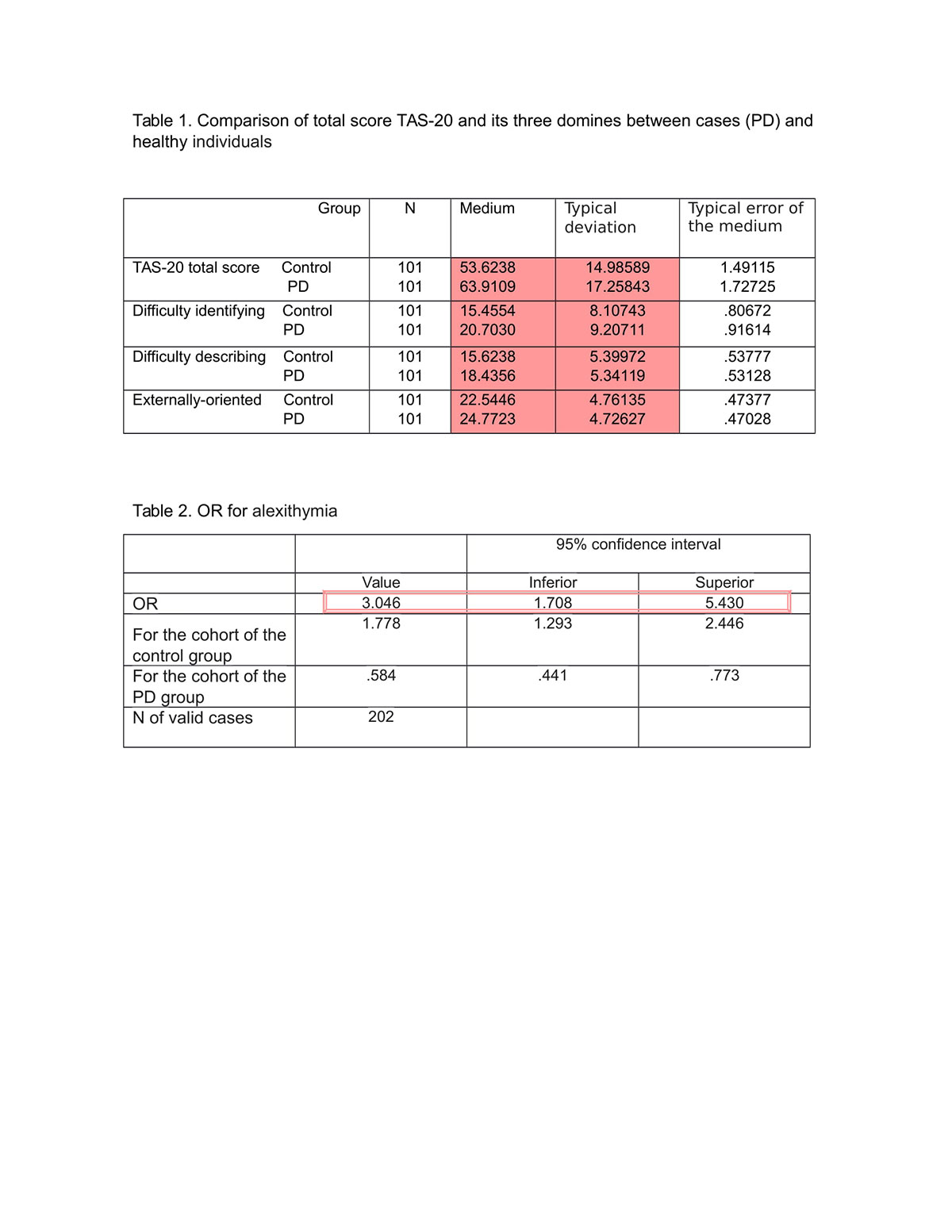Session Information
Date: Wednesday, September 25, 2019
Session Title: Non-Motor Symptoms
Session Time: 1:15pm-2:45pm
Location: Agora 3 West, Level 3
Objective: To identify the frequency of alexithymia in a Mexican sample of persons with Parkinson’s disease
Background: Alexithymia is related to a cognitive-affective alteration, characterized by the inability to describe their feelings, difficulty express them and a cognitive style oriented to the outside. The prevalence of alexithymia in PD varies from 18 to 23.8%, in patients with medication and patients with newly diagnosed PD (twice as much as in people without Parkinson’s Disease).
Method: A case-control study was carried out. Persons with PD were recruited from the outpatient Movement Disorders Clinic. Controls were recruited from healthy and unrelated persons in the waiting room. The presence of alexithymia was assessed using the twenty-Item Toronto Alexithymia scale (TAS-20). The TAS-20 is comprised by three dimensions: difficulty to identify emotions, to describe it and externally oriented thinking. Also, the TAS-20 allows to categorize subjects in three groups: without alexithymia, borderline and with alexithymia. Comparison between groups was carried out using Student T test for continuous variables and chi-square test for categorical variables. In addition, Odds Ratios were calculated.
Results: A total of 101 healthy individuals and 101 persons with Parkinson’s disease were included. The mean age was 60.8 years ± 11.9 years. The mean total score of the TAS-20 was 53.6 ± 14 in the control group versus 63 ± 17 in the PD group (p <0.001). In addition, statistical differences were found in the three individual domains (Table 1). When categorizing, 89 individuals had alexithymia, of which 65.2% corresponded to the group with PD and 38.4% to the control group. Of the 30 individuals classified as “borderline”, 43.3% had PD. On the other hand, 83 people were classified as "without alexithymia", 63.9% of which belonged to the control group. PD conferred an OR for alexithyimia of 3.04 (95% CI 1.7 -5.4, p< 0.001). Age- and sex-adjusted OR was 2.8 (CI 95% 1.569-5.118).
Conclusion: In our patients with PD, a higher prevalence of alexithymia was found compared to international reports. A three-fold increase in risk for alexithymia was found in persons with PD (Table 2).
References: References: 1. Assogna, F., Cravello, L., Orfei, M. D., Cellupica, N., Caltagirone, C., & Spalletta, G. (2016). Alexithymia in Parkinson’s disease: A systematic review of the literature. Parkinsonism and Related Disorders, 28(2016), 1–11. 2. ACCosta, A., Peppe, A., Carlesimo, G. a., Salamone, G., & Caltagirone, C. (2010). Prevalence and charac-teristics of alexithymia in Parkinson’s disease. Psychosomatics, 51(1), 22–28. 3. Goerlich-Dobre, K. S., Probst, C., Winter, L., Witt, K., Deuschl, G., Möller, B., & Van
To cite this abstract in AMA style:
L. Zuazua, M. Rodriguez, A. Cervantes, A. Balderas, R. Cruz, A. Alcocer, A. Perez, O. Esquivel, L. Navarro. Association of alexithymia and Parkinson’s Disease (PD) in Mexican population [abstract]. Mov Disord. 2019; 34 (suppl 2). https://www.mdsabstracts.org/abstract/association-of-alexithymia-and-parkinsons-disease-pd-in-mexican-population/. Accessed December 8, 2025.« Back to 2019 International Congress
MDS Abstracts - https://www.mdsabstracts.org/abstract/association-of-alexithymia-and-parkinsons-disease-pd-in-mexican-population/

